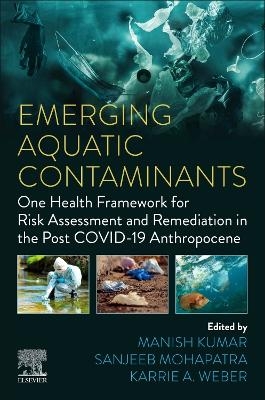
Emerging Aquatic Contaminants
Elsevier - Health Sciences Division (Verlag)
978-0-323-96002-1 (ISBN)
Dr. Manish Kumar is an assistant professor at Indian Institute of Technology Gandhinagar, Gujarat, India. He earned his PhD in Environmental Engineering from the University of Tokyo, Japan. He has more than >130 international journal publications. He is the recipient of recognitions like Expert Panel for UNEP on antimicrobial resistance, Fellow of the Royal Society of Chemistry (FRSC), Best Research Award at 4th IWA Asia Pacific Water Young Professional Conference, Global Change Research (GCR) Grant from Asia Pacific Network, DST young scientist grant, JSPS Research Fellowship, Centre of Excellence (CoE) Young Researcher Fund, and Linnaeus-Palme Grant from SIDA, Sweden. He renders the editorial service to several reputed journals. Dr. Sanjeeb Mohapatra works as a Marie Skłodowska Curie Postdoctoral (MSC) Fellow at the Faculty of Civil Engineering and Geosciences, Delft University of Technology, The Netherlands. Prior to this position, he worked as a Postdoctoral Research Scientist at the National University of Singapore. His research interest broadly covers the monitoring of emerging contaminants (ECs), photoelectrochemical (PEC) degradation of ECs, the role of dissolved organic matter in deciding the fate of such contaminants, and the circular economy approach to wastewater treatment. He is a recipient of the Water Advanced Research Innovation (WARI) Fellowship awarded by the Department of Science and Technology (DST), India, University of Nebraska Lincoln, USA, Daugherty Water for Food Global Institute (DWFI), USA, and Indo-U.S. Science and Technology Forum (IUSSTF). He is a recipient of the Newton-Bhabha Fellowship jointly awarded by DST, India, and British Council, U.K. He is also a recipient of the DST-INSPIRE fellowship offered by DST, India. Dr. Karrie A. Weber is Director of the Microbiology and Associate Professor in the School of Biological Sciences with a joint Appointment in the Department of Earth and Atmospheric Sciences at the University of Nebraska—Lincoln. Dr. Weber is also a Fellow of the Daugherty Water for Food Global Institute and member of the Child Health Research Institute. Dr. Weber completed her Ph.D. at the University of Alabama and continued postdoctoral training in the Department of Microbiology at Southern Illinois University and the Department of Plant and Microbial Biology at the University of California at Berkeley. Following her postdoctoral training Dr. Weber held a professional research position at the University of California at Berkeley before starting her position at the University of Nebraska Lincoln. Her research has focused on the identification and description of microbial metabolic processes that couple carbon, nitrogen, and metal/radionuclide biogeochemical processes in natural and anthropogenic systems that impact human and environmental health
Section I: Distribution, and occurrence of emerging contaminants
1. Sampling and analysis of emerging pollutants in aquatic environment Tirtha Mukherjee, Vajinder Kumar and Sukdeb Pal 2. Pharmaceutical and personal care products in the seawater: Mini review Chandrashekhar Bhagat and Manish Kumar 3. Microplastics in aquatic and atmospheric environments: Recent advancements and future perspectives Basanta Kumar Biswal and Rajasekhar Balasubramanian 4. Monitoring residues of neonicotinoid pesticides in paddy grains along the agro-ecosystems of the Cauvery delta region, South India Manjula Menon and Rangaswamy Mohanraj 5. Emerging COVID waste and its impact on the aquatic environment in India Rupa Chaudhuri, Punarbasu Chaudhuri, Aniruddha Mukhopadhyay and Pritha Bhattacharjee
Section II: Fate of emerging contaminants in the environment
6. Fate and transport of engineered nanoparticles in the subsurface: Current understanding,challenges, and future scope Rima Manik, Mahima John Horta and Seetha N. 7. Occurrence of per- and polyfluoroalkyl substances (PFAS): A special reference to their monitoring, distribution, and environmental fate Mengyang Liu, Abdul Qadeer, Muhammad Anis, Zeeshan Ajmal,Tadiyose Girma Bekele, Shuhang Wang, Xia Jiang and Kenneth M.Y. Leung 8. Occurrence and fate of biotoxins and their transformation products in the aquatic environment Prakash Ajay Taksal, Srija Arasavilli, Sahil Chauhan, Jayanta Bhattacharya, Brajesh Kumar Dubey and Shamik Chowdhury
Section III: Treatment strategies and advances
9. Efficacy of biotic components in constructed wetlands for mitigating pesticides Saloni Sachdeva, Jabili Chowdari, Ashmita Patro, Sunil Mittal and Prafulla Kumar Sahoo 10. Sources, consequences, and control of nanoparticles and microplastics in the environment A. Guhananthan, Aswin Kuttykattil, Thavamani Palanisami and Selvakumar Rajendran 11. Pesticides: Pollution, risks, and abatement measures Dhaneshwaree Asem, Mahima Kumari, L. Robindro Singh and Mayank Bhushan
Section IV: One health framework: Environmental and human health risk assessment
12. Controversial 1080 poison in New Zealand pest management Ravneel Chand, Hunter D.J. Webb and Rhonda J. Rosengren 13. Bioaccumulation of emerging contaminants in aquatic biota: PFAS as a case study Xunfeng Chen, Abdul Qadeer, Mengyang Liu, Linjing Deng, Pei Zhou, Innocent Tayari Mwizerwa, Sisi Liu, Zeeshan Ajmal, Zhao Xingru and Xia Jiang 14. Ecological effects of emerging contaminants:Ecotoxicity and relative environmental risk Chinmayee Das, Mario Vino Lincy G., Tajamul Shafi,Brajesh Kumar Dubey, Makarand M. Ghangrekar and Shamik Chowdhury 15. Evaluating the impact of exposure to emerging contaminants on human health Bokam Rajasekhar, Aishwarya Subramanian, Mridula Saravanan, Samarshi Chakraborty and Krishanasamy Sivagami
| Erscheinungsdatum | 27.03.2023 |
|---|---|
| Verlagsort | Philadelphia |
| Sprache | englisch |
| Maße | 152 x 229 mm |
| Gewicht | 450 g |
| Themenwelt | Naturwissenschaften ► Geowissenschaften ► Hydrologie / Ozeanografie |
| ISBN-10 | 0-323-96002-2 / 0323960022 |
| ISBN-13 | 978-0-323-96002-1 / 9780323960021 |
| Zustand | Neuware |
| Haben Sie eine Frage zum Produkt? |
aus dem Bereich


